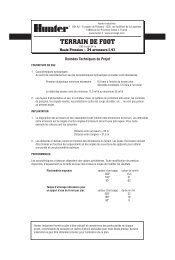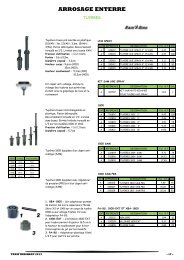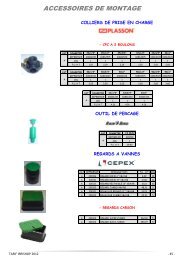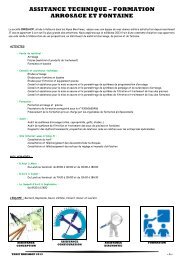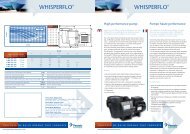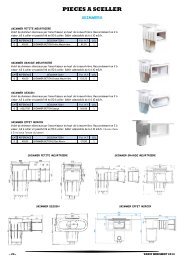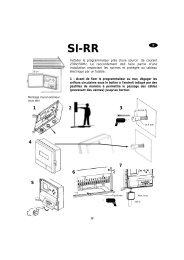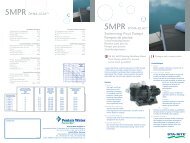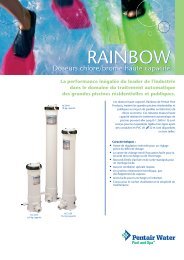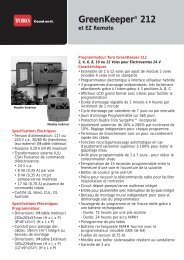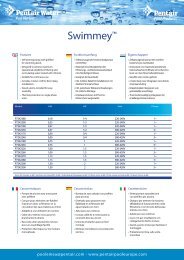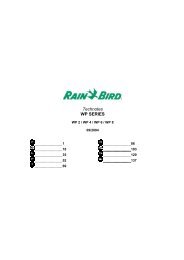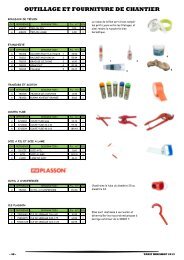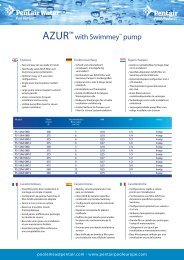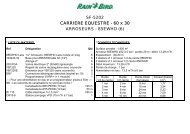La responsabilité de la société POLYPIPE MP ne pourrait
La responsabilité de la société POLYPIPE MP ne pourrait
La responsabilité de la société POLYPIPE MP ne pourrait
Create successful ePaper yourself
Turn your PDF publications into a flip-book with our unique Google optimized e-Paper software.
TUBE POLYETHYLENE HAUTE DENSITE - QUALITE ORGANOLEPTIQUE<br />
I<strong>MP</strong>ORTANT :<br />
Pour tout flui<strong>de</strong> véhiculé autre que <strong>de</strong> l’eau , s'assurer <strong>de</strong> <strong>la</strong> compatibilité par rapport aux normes NF T 54-070<br />
et ISO TR 10358.<br />
APPLICATIONS<br />
Réseaux adduction eau potable<br />
Distribution d’eaux brutes<br />
AVANTAGES DES TUBES EN PE<br />
! Résistance à <strong>la</strong> fissuration ! Résistance aux chocs et aux UV<br />
! Insensibilité à <strong>la</strong> corrosion ! Résistance à l’abrasion<br />
! Respect <strong>de</strong> <strong>la</strong> saveur <strong>ne</strong>utre <strong>de</strong> l’eau ! Peu sensible aux mouvements <strong>de</strong> terrain<br />
! Faible coefficient <strong>de</strong> rugosité, peu <strong>de</strong> perte <strong>de</strong> charge ! Légèreté et facilité <strong>de</strong> mise en œuvre, s’adapte aux<br />
! Souplesse tracés difficiles<br />
# Tube semi-rigi<strong>de</strong> <strong>de</strong> couleur noire avec un repérage spécifique ban<strong>de</strong>s bleues<br />
# Produit certifié à <strong>la</strong> marque NF 114. GROUPE 2. Co<strong>de</strong> d’i<strong>de</strong>ntification <strong>MP</strong><br />
# Conforme à <strong>la</strong> norme NF EN 12201-2<br />
# Conforme à <strong>la</strong> réglementation sanitaire –ACS (attestation <strong>de</strong> conformité sanitaire)<br />
# Conditionné en couron<strong>ne</strong>s, en barres ou en touret<br />
# Marquage tous les mètres<br />
# Tube bouchonné aux extrémités.<br />
LEXIQUE :<br />
PN : pression nominale correspondant à <strong>la</strong> valeur en bar d’u<strong>ne</strong> pression d’eau maintenue constante à l’intérieur<br />
du tube que celui-ci doit supporter sans défail<strong>la</strong>nce, avec u<strong>ne</strong> sécurité convenable pendant 50 ans à 20°C.<br />
SDR (rapport dimension<strong>ne</strong>l standardisé) : c’est le nombre arrondi qui exprime le rapport du diamètre nominal à<br />
l’épaisseur.<br />
Exemple :<br />
Tube PN 12.5 40 x 3.7<br />
40/3.7= 10.81 = SDR 11<br />
DETIMBRAGE : facteur correctif, inférieur à 1, à appliquer à <strong>la</strong> PN d’un réseau lorsque les conditions <strong>de</strong> fonction<strong>ne</strong>ment<br />
diffèrent notablement <strong>de</strong>s conditions standards (température > 20°C, produits chimiques , conditions mécaniques…).<br />
Exemple :<br />
<strong>La</strong> température du flui<strong>de</strong> est à 30°C :<br />
Le coefficient <strong>de</strong> détimbrage est <strong>de</strong> 0.87<br />
<strong>La</strong> Pression nominale (PN) est <strong>de</strong> 16 bar<br />
CARACTERISTIQUES DU POLYBLEU PE80<br />
T° du flui<strong>de</strong> (°C) 20° 25° 30° 35° 40°<br />
Coef <strong>de</strong> détimbrage 1 0.93 0.87 0.80 0.74<br />
<strong>La</strong> pression maximum admissible (PMA) à <strong>ne</strong> pas outrepasser dans le réseau est <strong>de</strong> : PN x Coef. <strong>de</strong> détimbrage soit :<br />
16 x 0.87 = 13,92 bar.<br />
CONDITIONS DE POSE<br />
<strong>La</strong> qualité <strong>de</strong> <strong>la</strong> mise en œuvre fera <strong>la</strong> performance du réseau<br />
Raccor<strong>de</strong>ment : Raccords éléctro-soudables, mécaniques<br />
Soudure bout à bout<br />
Pose enterrée :<br />
Le fond <strong>de</strong> fouille doit être propre , sans pierre ou point dur, d’u<strong>ne</strong> profon<strong>de</strong>ur conseillée <strong>de</strong> 0.80 m au <strong>de</strong>ssus du tube.<br />
Mettre en p<strong>la</strong>ce le tube sur un lit <strong>de</strong> sable d’u<strong>ne</strong> épaisseur d’au moins 10 cm.<br />
Recouvrir d’un lit <strong>de</strong> sable.<br />
Pose d’un gril<strong>la</strong>ge avertisseur bleu conseillé.<br />
Voir fascicule 71<br />
Page 1/2
Les rayons <strong>de</strong> courbure.<br />
Lors <strong>de</strong>s changements <strong>de</strong> direction <strong>la</strong> pose en courbe est à respecter puisqu’elle limite <strong>la</strong> perte <strong>de</strong> charge et les effets <strong>de</strong>s<br />
coups <strong>de</strong> béliers. Pour les tubes, en fonction du SDR, un rayon <strong>de</strong> courbure minimum est à respecter, selon le schéma<br />
suivant :<br />
Ces valeurs sont utilisables à 20°C.<br />
Pour u<strong>ne</strong> instal<strong>la</strong>tion par temps froid (0°C) il est<br />
nécessaire <strong>de</strong> doubler le rayon <strong>de</strong> courbure<br />
DN<br />
Retrait et di<strong>la</strong>tation.<br />
R ≥ 25 DN -SDR 11<br />
R ≥ 30 DN – SDR 13.6<br />
R ≥ 35 DN –SDR 17<br />
Réaliser <strong>de</strong>s ondu<strong>la</strong>tions pour compenser le retrait et <strong>la</strong> di<strong>la</strong>tation.<br />
Pour u<strong>ne</strong> variation <strong>de</strong> température <strong>de</strong> 20°C, <strong>la</strong> variation <strong>de</strong> longueur est <strong>de</strong> 0.40 m pour 100 mètres.<br />
CARACTERISTIQUES PHYSIQUES & MECANIQUES<br />
Types <strong>de</strong> tests Sur Matière PE 80 Sur Tube Normes <strong>de</strong> référence<br />
Masse volumique ≥ 930 kg/m3 ISO 1183 et ISO 1872/1+NF114<br />
Te<strong>ne</strong>ur en noir <strong>de</strong> carbo<strong>ne</strong> 2,0 à 2,5 % ISO 6964+NF114<br />
Indice <strong>de</strong> fluidité<br />
Valeur mesurée sur <strong>la</strong><br />
Valeur producteur<br />
composition<br />
± 20%<br />
± 10%<br />
ISO 1133+NF114<br />
Dispersion du noir <strong>de</strong> carbo<strong>ne</strong> ≤ 3 ≤ 3 ISO 18553+NF114<br />
Contrainte au seuil d'écoulement ≥ 15 <strong>MP</strong>a ISO 6259-1 et 3+NF114<br />
Allongement à <strong>la</strong> rupture ≥ 500 % ISO 6259-1 et 3+NF114<br />
Retrait à chaud ≤ 3% NF EN ISO 2505+NF114<br />
Résistance à <strong>la</strong> pression hydraulique > 165h sous 4,5 <strong>MP</strong>a NF EN ISO 1167-1 et 2<br />
à 80°C > 1000h sous 4,0 <strong>MP</strong>a +NF114<br />
CARACTERISTIQUES DIMENSIONNELLES<br />
Référence <strong>POLYPIPE</strong> <strong>MP</strong><br />
Diamètre extérieur (mm)<br />
Epaisseur (mm)<br />
Masse métrique<br />
Indicative en Kg/m<br />
PN 12.5 SDR 11 nominal tolérances nominale tolérances<br />
PB12032 32 -0 / +0,3 3.0 -0 / +0,4 0.277<br />
PB12040 40 -0 / +0,4 3.7 -0 / +0,5 0.428<br />
PB12050 50 -0 / +0,4 4.6 -0 / +0,6 0.665<br />
PB12063 63 -0 / +0,4 5.8 -0 / +0,7 1.050<br />
PB12075 75 -0 / +0,5 6.8 -0 / +0,8 1.470<br />
PB12090 90 -0 / +0,6 8.2 -0 / +1,0 2.130<br />
PB12110 110 -0 / +0,7 10.0 -0 / +1,1 3.150<br />
PB12125 125 -0 / +0,8 11.4 -0 / +1,3 4.090<br />
PN 16 SDR 9<br />
PB16020 20 -0 / +0,3 3.0 -0 / +0,4 0.162<br />
PB16025 25 -0 / +0,3 3.0 -0 / +0,4 0.210<br />
PB16032 32 -0 / +0,3 3.6 -0 / +0,5 0.326<br />
PB16040 40 -0 / +0,4 4.5 -0 / +0,6 0.510<br />
PB16050 50 -0 / +0,4 5.6 -0 / +0,7 0.790<br />
PB16063 63 -0 / +0,4 7.1 -0 / +0,9 1.260<br />
PB16075 75 -0 / +0,5 8.4 -0 / +1,0 1.770<br />
PB16090 90 -0 / +0,6 10.1 -0 / +1,2 2.550<br />
PB16110 110 -0 / +0,7 12.3 -0 / +1,4 3.790<br />
PB16125 125 -0 / +0,8 14.0 -0 / +1,6 4.880<br />
Pour toutes les autres pressions nous consulter<br />
<strong>La</strong> <strong>responsabilité</strong> <strong>de</strong> <strong>la</strong> <strong>société</strong> <strong>POLYPIPE</strong> <strong>MP</strong> <strong>ne</strong> <strong>pourrait</strong> être engagée en cas d'utilisation différente du produit et<br />
en cas <strong>de</strong> non respect <strong>de</strong>s conditions <strong>de</strong> pose.<br />
SPECIFICATIONS TECHNIQUES : SP-PB indice 0 du 05/02/07<br />
Page 2/2



